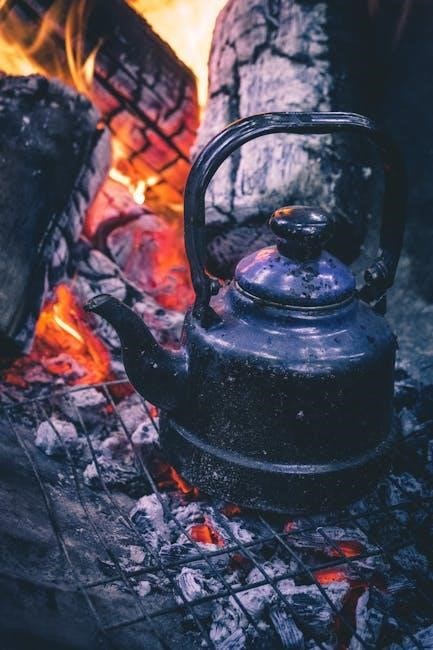The George Foreman Grill offers a versatile and efficient way to cook a variety of foods indoors. Known for its health benefits and even cooking, mastering temperature control is essential for achieving perfectly grilled meals. This guide provides a comprehensive overview of temperature settings, cooking times, and best practices to help you make the most of your George Foreman Grill.
Overview of the George Foreman Grill
The George Foreman Grill is a popular indoor electric grill designed for convenient and healthy cooking. It features a sloped surface that allows excess fat to drain away, reducing grease intake. Known for its versatility, the grill can cook a wide variety of foods, including meats, vegetables, sandwiches, and even fruits. The grill’s design ensures even heat distribution, promoting consistent cooking results. Available in multiple models, it ranges from basic analog controls to advanced digital temperature settings, catering to both casual users and cooking enthusiasts. Its compact size makes it ideal for small kitchens or outdoor events. By understanding the grill’s capabilities and temperature management, users can unlock its full potential for delicious, evenly cooked meals every time.
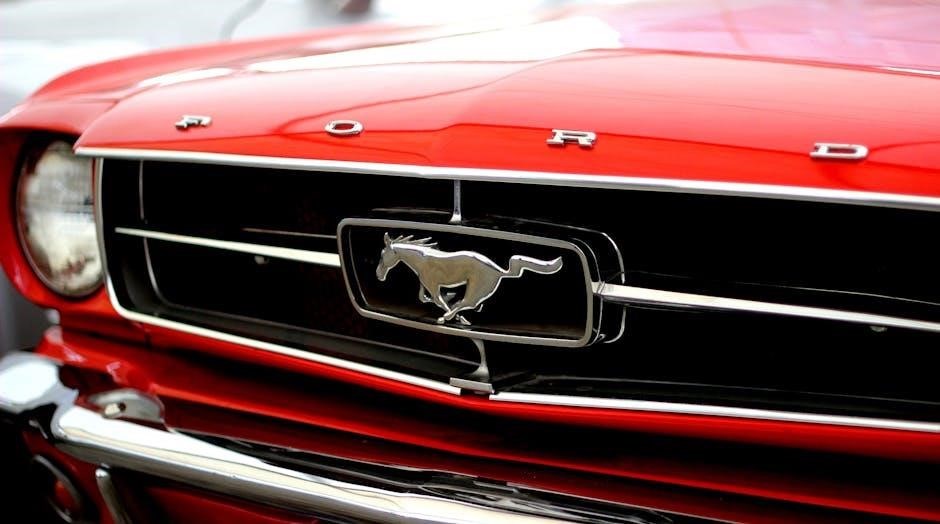
Importance of Temperature Control in Grilling
Temperature control is crucial for achieving optimal grilling results with the George Foreman Grill. Proper heat management ensures food is cooked evenly, preventing undercooking or overcooking. Different foods require specific temperature settings to achieve the desired doneness, whether it’s a juicy steak or tender chicken. Incorrect temperatures can lead to foodborne illnesses or a less flavorful meal. The grill’s ability to maintain consistent heat ensures that dishes are prepared safely and efficiently. By adhering to recommended temperature guidelines, users can enhance the texture and taste of their meals, making temperature control a fundamental aspect of mastering the George Foreman Grill.
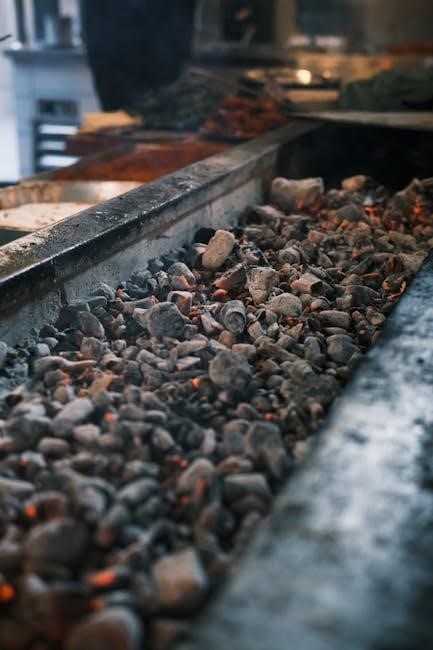
Understanding George Foreman Grill Temperature Settings
The George Foreman Grill features adjustable temperature settings, typically ranging from 195°C to 245°C, with some models reaching up to 500°F. Digital and analog controls offer precise heat management for diverse cooking needs.
Typical Temperature Ranges for George Foreman Grills
George Foreman Grills generally operate within a temperature range of 195°C to 245°C (380°F to 475°F), with some advanced models reaching up to 400°F, 425°F, or even 500°F. These grills are designed to preheat quickly, typically within three to five minutes, ensuring efficient cooking. The temperature settings vary by model, with digital and analog controls offering precise adjustments. For most meats, a medium-high heat setting of around 375°F (190°C) is recommended, while fish and vegetables may require lower temperatures. Understanding these ranges is crucial for achieving optimal cooking results. Always refer to your specific model’s guidelines for exact temperature capabilities and adjustments.
Digital vs. Analog Temperature Controls
George Foreman Grills are available with both digital and analog temperature controls, catering to different user preferences. Digital controls offer precise temperature adjustment, often with LCD displays and preset settings for specific foods. They provide greater accuracy and ease of use, especially for novice grillers. Analog controls, on the other hand, feature a simple dial for adjusting heat, offering a more traditional grilling experience. While digital models are ideal for those who value exact temperature control, analog grills are often more straightforward and require less maintenance. Both options ensure consistent heat distribution, but digital controls typically include additional features like timers and customizable settings, enhancing the overall grilling experience.
How to Adjust Temperature Settings for Different Foods
Adjusting temperature settings on your George Foreman Grill is crucial for optimal cooking results. For delicate foods like fish or vegetables, a medium-low heat setting (around 325°F) is recommended to prevent burning. Meats such as steak and chicken require higher temperatures, typically between 375°F to 400°F, to achieve a perfect sear and even cooking. When grilling poultry, ensure the internal temperature reaches 165°F for safety. For burgers and sandwiches, a medium-high setting (350°F to 375°F) works best, ensuring a crisp exterior and a well-cooked interior. Always refer to the specific food’s thickness and desired doneness to fine-tune your temperature adjustments, ensuring a perfectly grilled meal every time.

Preheating Your George Foreman Grill
Preheating your George Foreman Grill ensures even cooking and prevents food from sticking. Most models preheat to 400°F in 3-5 minutes. Always preheat before cooking for optimal results.
Why Preheating is Crucial for Even Cooking
Preheating your George Foreman Grill is essential for achieving consistent results. It ensures the grill reaches the optimal temperature, preventing hot spots that can lead to uneven cooking. Proper preheating also helps sear food effectively, locking in juices and flavors. Without preheating, food may stick to the grill plates or cook inconsistently, resulting in undercooked or overcooked areas. Most models preheat quickly, reaching high temperatures like 400°F in just a few minutes. This step is vital for delivering tender, evenly cooked meals every time, whether you’re grilling meats, vegetables, or sandwiches. By preheating, you set the stage for a perfectly grilled dish with professional-grade results.
Steps to Preheat Your George Foreman Grill
Preheating your George Foreman Grill is a straightforward process that ensures optimal cooking results. Start by plugging in the grill and setting the temperature using the control dial or digital interface, depending on your model. For most models, preheating takes 3 to 5 minutes. Once the grill is turned on, allow it to heat up uninterrupted. Some models feature indicator lights that turn off or change color when preheating is complete. Always ensure the grill plates are clean before preheating to prevent any residual food from burning. Once preheated, the grill is ready for cooking. For precise results, refer to your user manual for specific preheating instructions tailored to your grill model. Proper preheating is key to achieving evenly cooked, flavorful dishes every time.
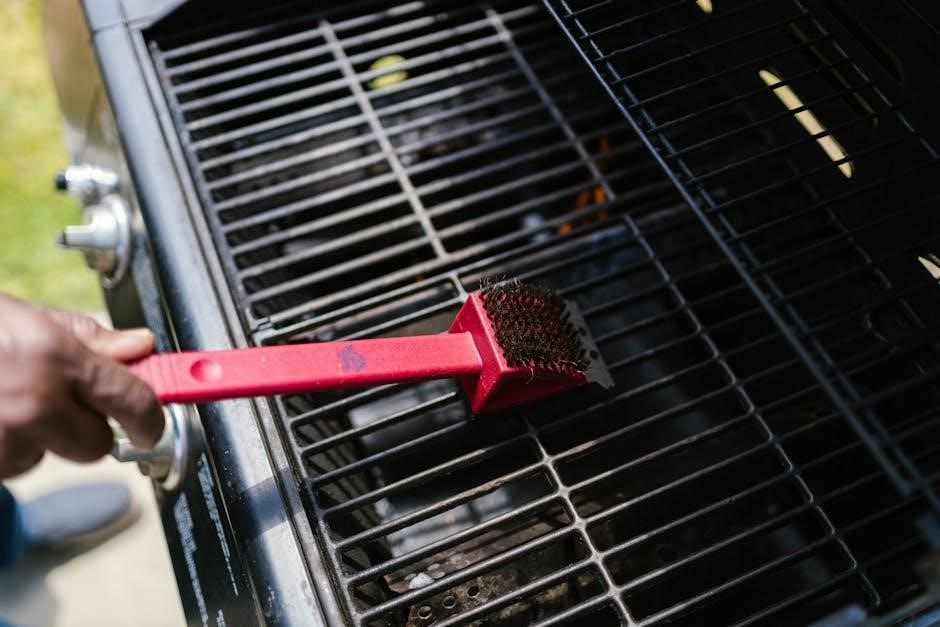
Recommended Preheating Times for Different Models
Preheating times for George Foreman Grills vary slightly depending on the model. Basic models typically require 3-4 minutes to reach optimal temperature, while mid-range models with digital controls may take 4-5 minutes. Advanced models, such as those with precision temperature probes, often preheat in 5-6 minutes. For grills with variable temperature settings, the preheating time remains consistent across settings. Always refer to your specific model’s user manual for exact preheating times, as some high-end models may have faster heating capabilities. Proper preheating ensures even cooking and prevents undercooked or overcooked results. By following these guidelines, you can maximize the performance of your George Foreman Grill and achieve consistent, delicious outcomes.

Cooking Times and Temperatures for Specific Foods
This guide provides detailed cooking times and temperatures for meats, poultry, seafood, vegetables, fruits, and sandwiches, ensuring perfectly cooked meals every time on your George Foreman Grill.
Meat Cooking Guide
Cooking meat on the George Foreman Grill requires attention to temperature and thickness for perfect results. For steaks, medium-high heat (375-400°F) is ideal, with cooking times ranging from 4-7 minutes for medium-rare and 6-9 minutes for medium. Burgers should be cooked at high heat (400°F) for 4-6 minutes, adjusting slightly for frozen patties. Pork chops fare best at medium-high heat, needing 8-11 minutes for ½-inch thickness. Ensure internal temperatures reach safe levels: 145°F for steak, 160°F for burgers, and 145°F for pork. Use a meat thermometer for accuracy and avoid overcooking for juicy, flavorful outcomes. These guidelines help you achieve tender, perfectly grilled meats every time with your George Foreman Grill.
Poultry Cooking Guide

Cooking poultry on the George Foreman Grill requires precise temperature control to ensure safety and flavor. For boneless, skinless chicken breasts, cook at 350-375°F for 6-8 minutes, achieving an internal temperature of 165°F. Chicken breasts around 1 inch thick typically take 9-11 minutes. Turkey burgers should be grilled at the same temperature range, needing 6-8 minutes for full doneness. When cooking poultry, avoid pressing down on the meat, as this can push out juices and lead to dryness. Always use a meat thermometer to confirm internal temperatures, ensuring food safety. These guidelines help you achieve perfectly cooked, juicy poultry with minimal effort on your George Foreman Grill.
Seafood Cooking Guide
Cooking seafood on the George Foreman Grill requires attention to temperature and timing to preserve delicate flavors and textures. Fish steaks, such as cod or salmon, cook best at medium-high heat (375°F) for 4-6 minutes per side, ensuring an internal temperature of 145°F. Shrimp can be grilled in 2-4 minutes per side, while scallops require 3-5 minutes, turning halfway. For frozen seafood, like cod fillets, preheat the grill to 375°F and cook for 4-6 minutes, flipping once. Avoid overcrowding the grill to ensure even cooking. Use a meat thermometer to confirm doneness, especially for thicker fish. These guidelines help you achieve perfectly cooked, flavorful seafood every time on your George Foreman Grill.
Vegetable Cooking Guide
The George Foreman Grill is ideal for cooking vegetables, offering a healthy and flavorful way to prepare your favorite veggies. Preheat the grill to medium-high heat (375°F) for most vegetables. Sliced zucchini, bell peppers, and onions cook in 3-5 minutes per side, while thicker vegetables like asparagus or mushrooms may require 5-7 minutes. For softer textures, brush vegetables with oil and season before grilling. Frozen vegetables, like broccoli or cauliflower, can be cooked directly on the grill at 375°F for 5-7 minutes, stirring occasionally. Ensure even cooking by slicing vegetables uniformly. Use a meat thermometer to check doneness, especially for heartier vegetables. These guidelines help you achieve tender, caramelized results, making the George Foreman Grill a versatile tool for vegetable preparation.
Fruit Cooking Guide
The George Foreman Grill adds a delicious twist to cooking fruits, enhancing their natural sweetness. Preheat the grill to medium heat (325-350°F) for most fruits. Sliced bananas or pineapple rings cook in 2-4 minutes per side, developing a caramelized crust. Thicker fruits like peach or nectarine slices may require 4-6 minutes per side. Apples, cut into wedges, cook best at 325°F for 5-7 minutes, achieving a tender yet slightly charred texture. Brush fruits with a little oil or honey before grilling for added flavor. Sprinkle with cinnamon or other spices for a dessert-like treat. Ensure even cooking by flipping gently with a spatula. These guidelines help you unlock the full potential of grilling fruits, creating a sweet and savory experience every time.
Sandwiches and Paninis Cooking Guide
The George Foreman Grill is ideal for crafting delicious sandwiches and paninis with minimal effort. Preheat the grill to medium heat (325-350°F) for optimal results. Place sandwiches on the grill, ensuring even contact for consistent cooking. Cook for 4-7 minutes, or until the bread is golden brown and the filling is heated through. For paninis, use a slightly higher heat (350°F) and cook for 5-8 minutes to achieve a crispy crust. Lightly buttering the bread before grilling enhances flavor and texture. Ensure the grill is preheated to prevent sticking and promote even cooking. These guidelines help you create perfectly toasted, flavorful sandwiches and paninis every time, making the George Foreman Grill a versatile tool for both classic and gourmet recipes.
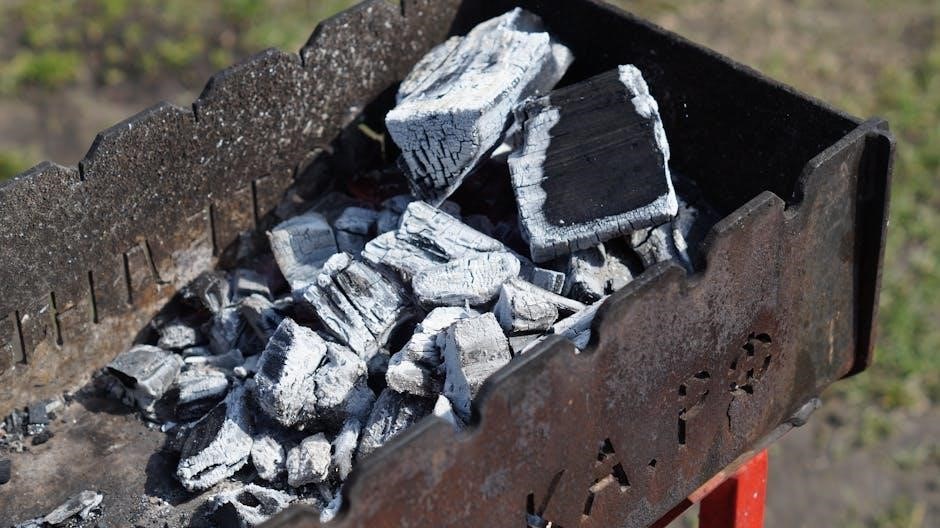
Best Practices for Grilling with the George Foreman Grill
Maintain consistent performance by cleaning the grill after each use. Ensure food is dry to prevent sticking and promote even cooking. Always use a meat thermometer for precise doneness, enhancing flavor and safety.
Food Preparation Tips for Optimal Grilling
Proper food preparation is key to achieving the best results with your George Foreman Grill. Always preheat the grill to the recommended temperature before cooking to ensure even heat distribution. Pat dry meats, poultry, and fish with paper towels to remove excess moisture, which helps prevent steaming and promotes browning. Trim excess fat from meats to avoid flare-ups and ensure consistent cooking. For vegetables, brush with oil and season lightly to enhance flavor without overpowering the natural taste. Ensure food is at room temperature before grilling to avoid uneven cooking. Portion food evenly, especially for items like burgers or sandwiches, to guarantee uniform cooking. Finally, avoid overcrowding the grill surface, as this can lower the temperature and lead to undercooked or steamed food. These simple steps will help you achieve perfectly grilled dishes every time.
Using a Meat Thermometer for Perfect Doneness
A meat thermometer is an essential tool for ensuring your grilled foods reach the perfect level of doneness. It allows you to monitor internal temperatures accurately, which is critical for food safety and optimal flavor. For example, chicken breasts should be cooked to an internal temperature of 165°F (74°C), while steak can range from 130°F (54°C) for medium-rare to 160°F (71°C) for medium-well. Ground meats, like burgers, should reach at least 160°F (71°C) to prevent undercooking. Always insert the thermometer into the thickest part of the meat, avoiding bone or fat for an accurate reading. Let it rest for a few seconds before checking the temperature. Digital thermometers are highly recommended for their precision and speed. By using a meat thermometer, you can achieve consistent results and ensure your grilled dishes are both safe and delicious.
Maintenance and Cleaning for Consistent Performance
Regular maintenance and cleaning are vital to ensure your George Foreman Grill performs consistently and lasts for years. After each use, unplug the grill and let it cool slightly before cleaning. Use a soft brush or damp cloth to wipe down the grilling surfaces, removing any food residue. For tougher stains, a gentle scrub with a non-abrasive sponge and mild soap can be effective. Avoid harsh chemicals or metal scourers, as they may damage the non-stick coating. The drip tray should be emptied and washed with soap and warm water after every use to prevent grease buildup; Proper cleaning prevents food particles from interfering with heat distribution and ensures even cooking. By maintaining your grill, you’ll preserve its efficiency and continue to achieve perfectly grilled meals every time.

Advanced Grilling Techniques
Master advanced techniques like achieving perfect sears, preventing food from sticking, and creating professional-grade grill marks. These methods enhance flavor and texture, elevating your grilling experience.
Achieving the Perfect Sear
Achieving the Perfect Sear
Achieving the perfect sear on your George Foreman Grill enhances both flavor and texture. Preheat the grill to medium-high heat, typically around 375°F to 400°F, ensuring the surface is hot before adding food. Pat dry meats or fish to remove excess moisture, as a dry surface sears better. Lightly brush the grates with oil to prevent sticking. Place your food evenly and close the lid. Avoid moving the food during the searing process to allow a crust to form. For steaks, sear for 4-5 minutes per side, while chicken breasts may need 5-6 minutes. This technique locks in juices and creates a crispy, caramelized exterior, making your dishes restaurant-quality. Proper searing also adds visual appeal, making your meals more appetizing. Experiment with different seasonings before searing for added flavor depth.
Preventing Food from Sticking to the Grill
Preventing food from sticking to the George Foreman Grill ensures a smooth cooking experience and preserves the quality of your dishes. Always preheat the grill to the recommended temperature before adding food, as a hot surface prevents sticking. Lightly brush the grill plates with oil or non-stick cooking spray, especially if you’re grilling delicate foods like fish or vegetables. For added protection, ensure food is dry or lightly oiled before grilling. Avoid overcrowding the grill, as this can cause food to steam instead of sear. If using marinades, pat excess moisture off with a paper towel before grilling. For stubborn cases, gently nudge food with a spatula after cooking for a few minutes to ensure it doesn’t adhere. Regularly cleaning the grill after use also prevents residue buildup, which can cause sticking over time. Proper maintenance and preparation ensure your George Foreman Grill performs optimally.
Grill Marks: How to Achieve Professional-Grade Results
Achieving professional-grade grill marks on your George Foreman Grill enhances both the visual appeal and flavor of your dishes. To create perfect sear marks, preheat the grill to the optimal temperature for your food type, ensuring the plates are hot before adding food. Lightly oil the grill plates or brush food with oil to prevent sticking and promote even browning. Place food at a 45-degree angle to the grill lines for distinctive marks. Avoid moving or flipping food too soon, as this disrupts the searing process. Once sear marks form, reduce heat if necessary to finish cooking without burning. For clean, sharp marks, ensure the grill is free of residue and clean it after each use. These techniques will help you achieve restaurant-quality grill marks with ease.

Common Questions and Solutions
Common questions include adjusting temperatures, avoiding overcooking, and troubleshooting temperature-related issues. Ensure proper preheating, monitor doneness, and refer to the guide for optimal results and solutions to these queries.
Can You Change the Temperature on a George Foreman Grill?
Yes, most George Foreman Grill models allow temperature adjustment. Digital and analog controls are available, depending on the model. Adjusting the temperature ensures optimal cooking for various foods.
How to Avoid Overcooking or Undercooking
Avoiding overcooking or undercooking is crucial for achieving perfectly grilled meals. Always refer to the recommended temperature and cooking time guidelines for your specific food type. Use a meat thermometer to ensure internal temperatures meet safety standards. Preheating the grill to the correct temperature before cooking is essential for even heat distribution. Keep an eye on food thickness, as thicker cuts require longer cooking times. Avoid overcrowding the grill, as this can disrupt airflow and lead to uneven cooking. For delicate foods like fish or vegetables, monitor cooking time closely to prevent burning. Adjusting the grill’s temperature settings and using the timer function can also help maintain control. By following these steps, you can ensure your dishes are cooked to perfection every time.
Troubleshooting Temperature-Related Issues
If your George Foreman Grill is not heating evenly or reaching the desired temperature, ensure it is preheated properly and free from debris. Clean the grill plates regularly to avoid residue buildup, which can interfere with heat distribution. Check the power supply and ensure the grill is plugged into a functioning outlet. If the temperature control is not responding, restart the grill or refer to the user manual for recalibration instructions. For models with digital controls, ensure the display is functioning correctly. If issues persist, contact customer support or consult the troubleshooting section of your grill’s manual. Always use a meat thermometer to verify internal food temperatures and adjust cooking times as needed to avoid overcooking or undercooking. Proper maintenance and adherence to guidelines will ensure consistent performance and optimal grilling results.
Mastery of the George Foreman Grill begins with understanding its temperature settings. By following this guide, you’ll achieve perfectly cooked meals every time. Keep experimenting and enjoy grilling!
Recap of Key Temperature Guidelines
Mastery of the George Foreman Grill hinges on understanding its temperature settings. For most meats, a medium-high heat setting of around 375°F (190°C) is ideal. Boneless, skinless chicken breasts cook perfectly at 350-375°F for 6-8 minutes, while steak sears best at 375-400°F. Seafood like fish requires lower temperatures, around 325-350°F, to prevent overcooking. Vegetables and fruits thrive at medium heat, ensuring even cooking without charring. Preheating is crucial, with most models reaching optimal temperatures in 3-5 minutes. Always use a meat thermometer to ensure doneness, especially for poultry, which needs an internal temperature of 165°F. Digital controls offer precision, but analog models still deliver consistent results. Adjust cooking times based on food thickness and desired doneness. By adhering to these guidelines, you’ll achieve perfectly grilled meals every time. Experiment with settings to find your ideal balance of flavor and texture.
Final Tips for Mastering the George Foreman Grill
Mastering the George Foreman Grill involves a combination of proper temperature control, food preparation, and technique. Always preheat the grill to ensure even cooking and a perfect sear. Pat dry foods before grilling to prevent steaming and promote browning. Use a meat thermometer for precise doneness, especially for poultry and steak. Don’t overcrowd the grill; cook in batches if necessary. For delicate foods like fish, lower the heat to avoid burning. Regularly clean the grill to maintain its performance and prevent food residue buildup. Experiment with marinades and seasonings to enhance flavor without adding extra oil. Finally, refer to the cooking chart for specific guidelines, but adjust times based on food thickness and personal preference. By following these tips, you’ll unlock the full potential of your George Foreman Grill and enjoy healthier, tastier meals with ease.
